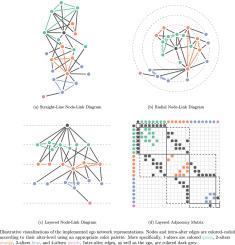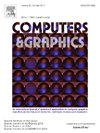Me! Me! Me! Me! A study and comparison of ego network representations
IF 2.8
4区 计算机科学
Q2 COMPUTER SCIENCE, SOFTWARE ENGINEERING
引用次数: 0
Abstract
From social networks to brain connectivity, ego networks are a simple yet powerful approach to visualizing parts of a larger graph, i.e. those related to a selected focal node — the so-called “ego”. While surveys and comparisons of general graph visualization approaches exist in the literature, we note (i) the many conflicting results of comparisons of adjacency matrices and node-link diagrams, thus motivating further study, as well as (ii) the absence of such systematic comparisons for ego networks specifically. In this paper, we propose the development of empirical recommendations for ego network visualization strategies. First, we survey the literature across application domains and collect examples of network visualizations to identify the most common visual encodings, namely straight-line, radial, and layered node-link diagrams, as well as adjacency matrices. These representations are then applied to a representative, intermediate-sized network and subsequently compared in a large-scale, crowd-sourced user study in a mixed-methods analysis setup to investigate their impact on both user experience and performance. Within the limits of this study, and contrary to previous comparative investigations of adjacency matrices and node-link diagrams (outside of ego networks specifically), participants performed systematically worse when using adjacency matrices than those using node-link diagrammatic representations. Similar to previous comparisons of different node-link diagrams, we do not detect any notable differences in participant performance between the three node-link diagrams. Lastly, our quantitative and qualitative results indicate that participants found adjacency matrices harder to learn, use, and understand than node-link diagrams. We conclude that in terms of both participant experience and performance, a layered node-link diagrammatic representation appears to be the most preferable for ego network visualization purposes.

我我!我!我自我网络表征的研究与比较
从社交网络到大脑连通性,"自我 "网络是一种简单而强大的方法,可用于可视化更大图形的各个部分,即与选定的焦点节点(即所谓的 "自我")相关的部分。虽然文献中存在对一般图形可视化方法的调查和比较,但我们注意到:(i) 在邻接矩阵和节点链接图的比较中存在许多相互矛盾的结果,因此需要进一步研究;(ii) 缺乏专门针对自我网络的系统性比较。在本文中,我们提出了关于自我网络可视化策略的经验性建议。首先,我们调查了各应用领域的文献,并收集了网络可视化实例,以确定最常见的可视化编码方式,即直线图、径向图、分层节点链接图以及邻接矩阵。然后,将这些表示法应用于一个具有代表性的中等规模网络,并在随后进行的大规模众包用户研究中通过混合方法分析设置进行比较,以研究它们对用户体验和性能的影响。在本研究的范围内,与以往对邻接矩阵和节点链接图(特别是在自我网络之外)的比较研究相反,参与者在使用邻接矩阵时的表现明显比使用节点链接图表示法时差。与之前对不同节点链接图的比较类似,我们没有发现三种节点链接图之间参与者表现的明显差异。最后,我们的定量和定性结果表明,参与者发现邻接矩阵比节点链接图更难学习、使用和理解。我们的结论是,就参与者的体验和表现而言,分层节点链接图似乎最适合用于自我网络可视化目的。
本文章由计算机程序翻译,如有差异,请以英文原文为准。
求助全文
约1分钟内获得全文
求助全文
来源期刊

Computers & Graphics-Uk
工程技术-计算机:软件工程
CiteScore
5.30
自引率
12.00%
发文量
173
审稿时长
38 days
期刊介绍:
Computers & Graphics is dedicated to disseminate information on research and applications of computer graphics (CG) techniques. The journal encourages articles on:
1. Research and applications of interactive computer graphics. We are particularly interested in novel interaction techniques and applications of CG to problem domains.
2. State-of-the-art papers on late-breaking, cutting-edge research on CG.
3. Information on innovative uses of graphics principles and technologies.
4. Tutorial papers on both teaching CG principles and innovative uses of CG in education.
 求助内容:
求助内容: 应助结果提醒方式:
应助结果提醒方式:


